Aren’t you glad that the Otari Hoodie Sew Along is finished?
First, it means that some of you have awesome hoodies that you can wear. And second, it means that I can stop blogging hoodie instructions, and go back to blogging about random historical things, and whatever else I’m working on.
Right now, the ‘random historical things’ means catching up on all the stuff I haven’t been blogging about while I was hoodie-ing, starting with the Sew & Eat Historical Retreat.
I promised menu details in my first post, so here is more information.
The real credit for the menu and cooking goes to Nina, who put together all the more spectacular and involved items, most of which I would never dare attempt*. Hopefully she’ll blog more details about her food, so mine will be a briefer overview.
I didn’t manage to photograph everything, as I got too excited about actually eating things, and just having fun.
Friday Dinner: ‘Malaga-tawnee Curee’ with potted hare
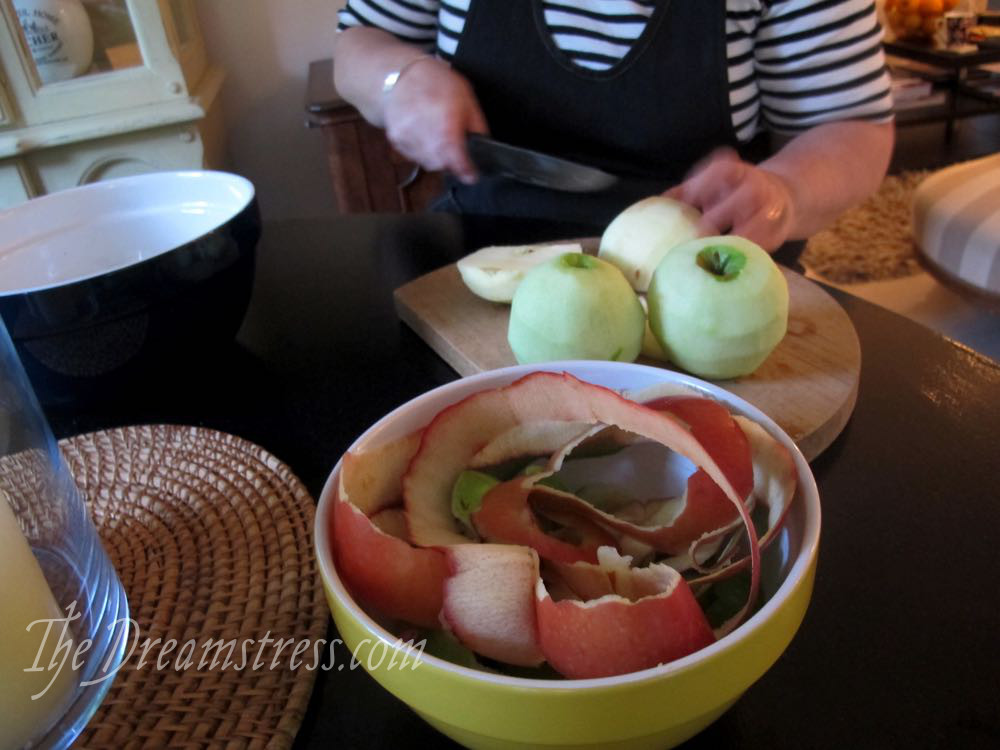
Friday’s dinner was based on two extent Regency curry recipes (one belonging to Jane Austen’s sister in law), the description of curry eating in Vanity Fair***, and recipes for potted hare.
I couldn’t find an original Regency curry recipe that used potted hare as the meat, but it was certainly a common meat source, and I was able to find a whole wild hare at Moore Wilsons (the fancy Wellington supermarket†).
The curry included apples and lentils, and there was so much of it that we had it for lunch on Saturday too. And it was delicious. In fact, a vegetarian version††of it has become part of my regular meal rotation. You can find a similar-ish recipe here (just omit the coconut milk).
Saturday Afternoon Tea:
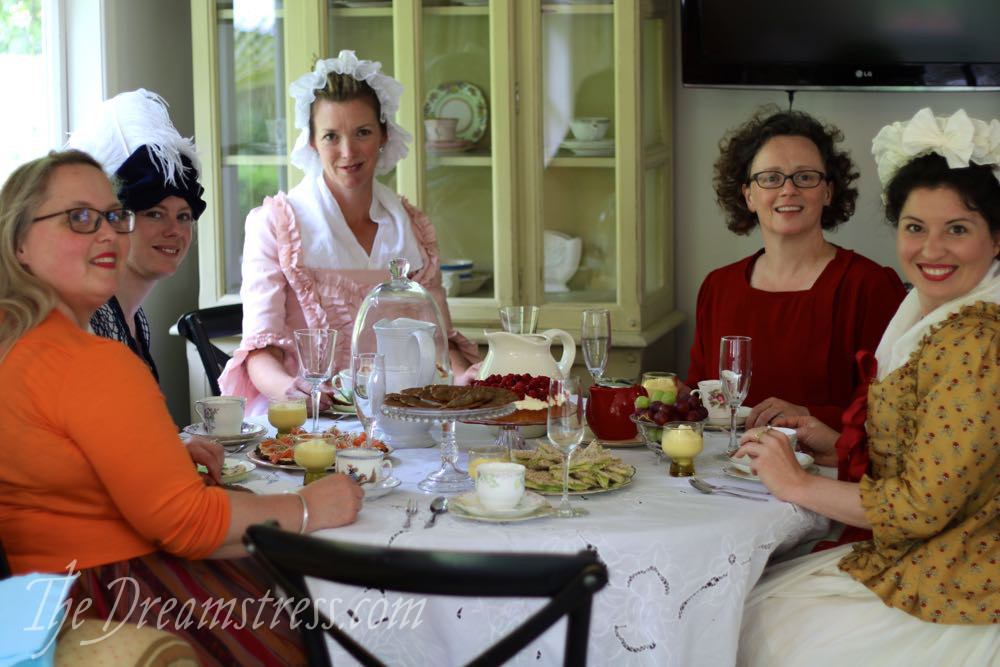
Menu:
Cucumber sandwiches
Devilled eggs variations on devilled eggs date back to Roman times, and the little savoury egg-parcels were definitely popular in the 19th century.
Salmon & capers with cream cheese on pumpernickel ††â€
Fruit
Ginger honeycomb biscuits‡
Rice flour Victorian cake‡
Lemon ices (Jane Austen wrote of eating ices at her brother Edward’s estate, and Gunter’s Tea Shop, which took over from the Pot & Pineapple‡‡ in 1799, was famous for its ices)
Tea
Rhubarb & Ginger Cordial
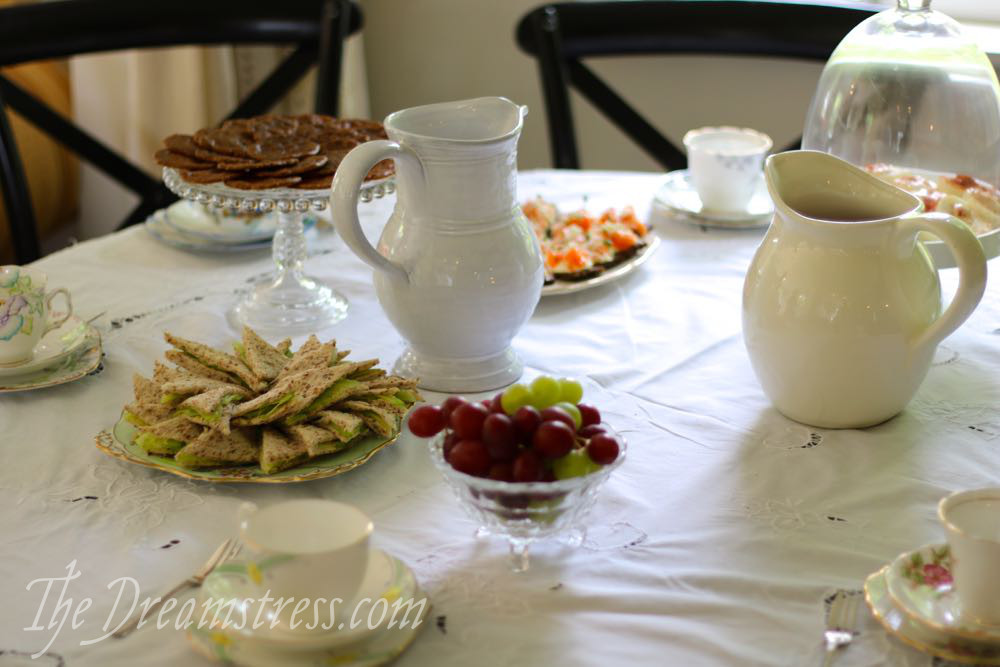
Sunday Lunch: Salmagundi
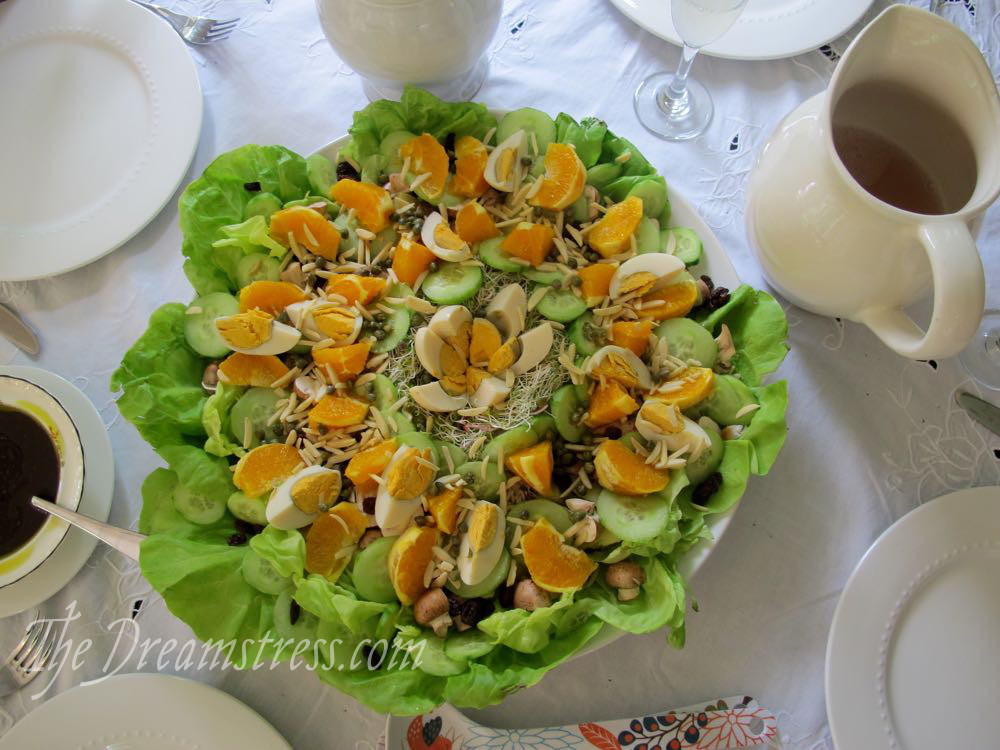
I used the recipe in the 17th century The Good Huswives Treasure (quoted on Wikipedia) as my starting point, and added lots of lettuce and sprouts. Instead of chicken (which I don’t eat) we used smoked mackerel as the protein, as well as hard boiled eggs, which appear in numerous other salmagundi recipes. We omitted oysters because of a shellfish allergy‡‡‡, and olives, because I forgot to buy them. We meant to include broombuds because there is feral broom all over Wellington, but sadly we didn’t see any around our cottage.
And it was delicious and wonderful and just what we all wanted to eat…
Sunday Gala Dinner:
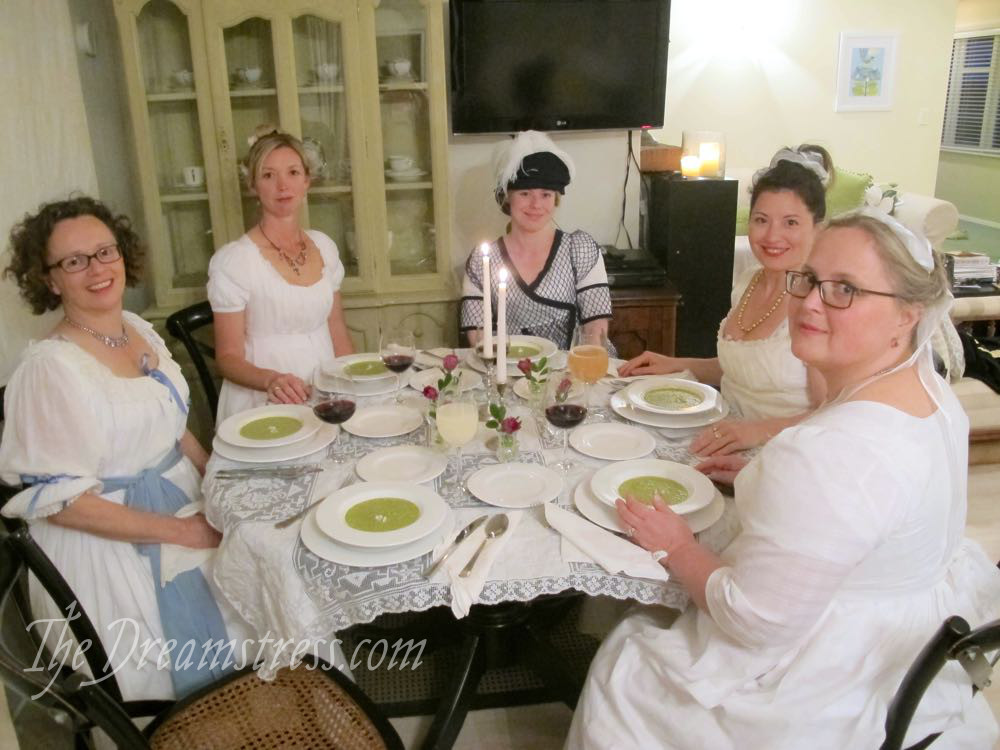
First Course: Swiss Soup Meagre
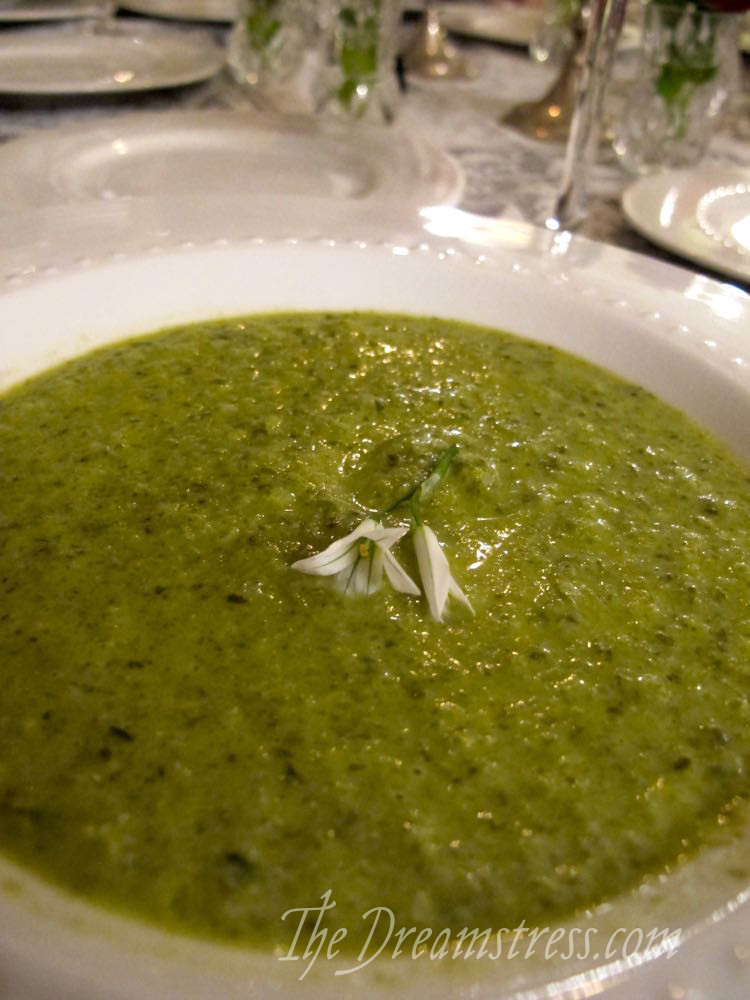 There are numerous historical variations of this recipe, dating from the early 18th century, to the late 18th, but generally it calls for you to take any sort of spring greens you can rummage up, saute them in copious amounts of butter, add beaten eggs, and push through a sieve.
There are numerous historical variations of this recipe, dating from the early 18th century, to the late 18th, but generally it calls for you to take any sort of spring greens you can rummage up, saute them in copious amounts of butter, add beaten eggs, and push through a sieve.
We used the one given here as a starting point. Our vegetables were spinach, lettuce, cabbage, watercress, leeks, and, for a very authentically harvested-from-your-spring-garden touch, onion weed collected from the cottage yard. You can see the onion weed flowers as garnish.
Second Course: Salmon mousse and cucumber salad with toast
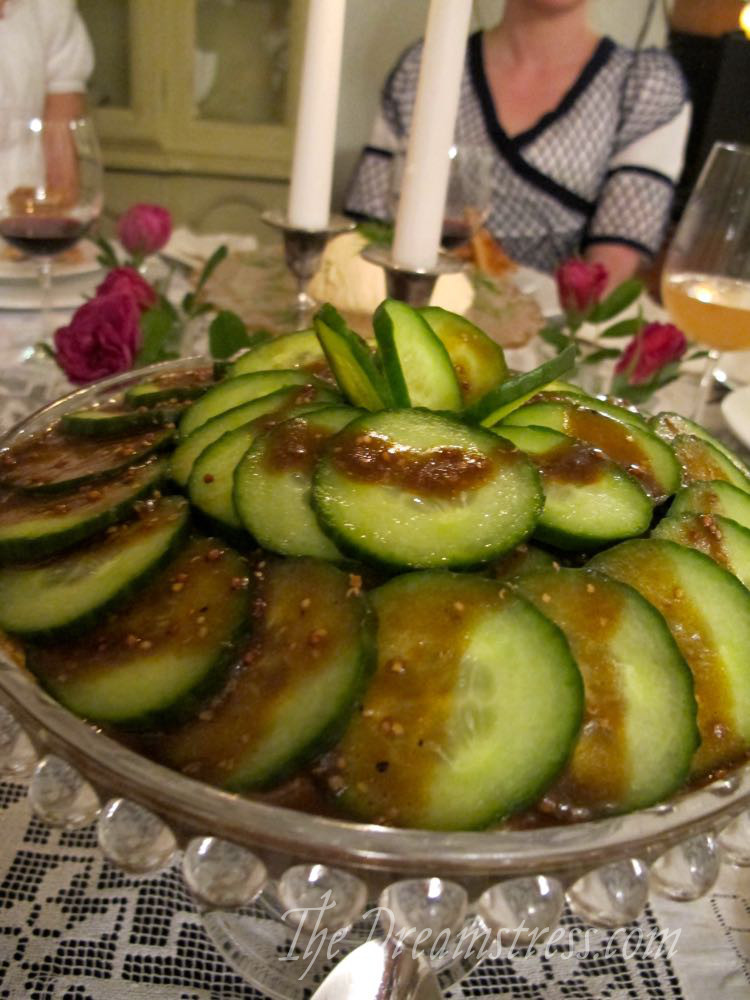
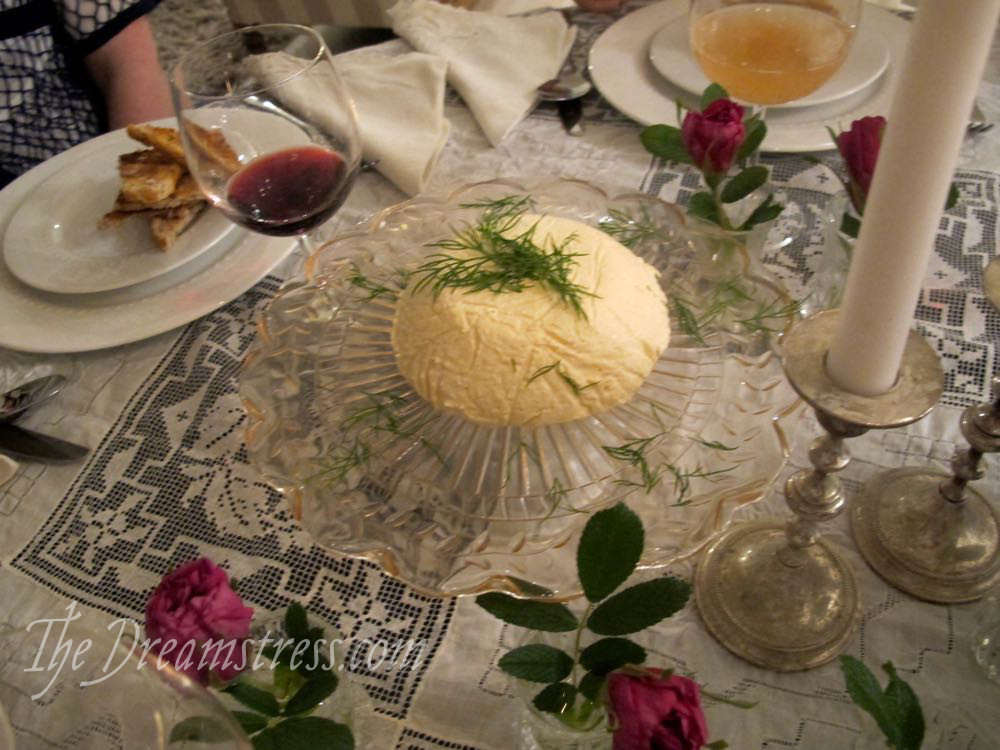
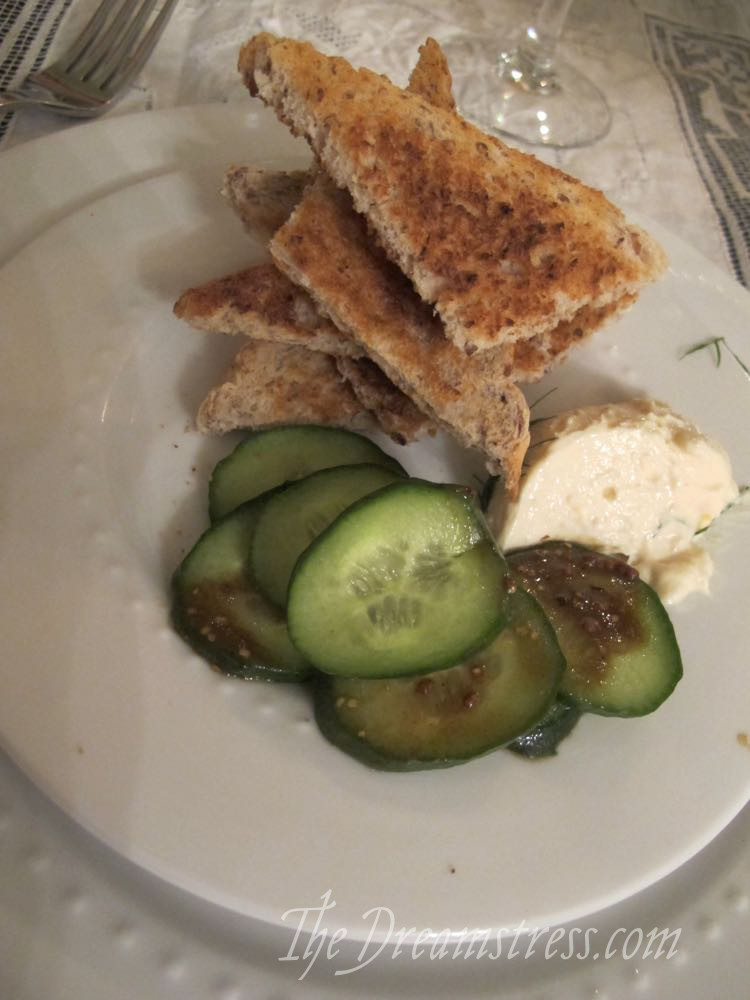
Main Course: Venison en croute (gluten free)
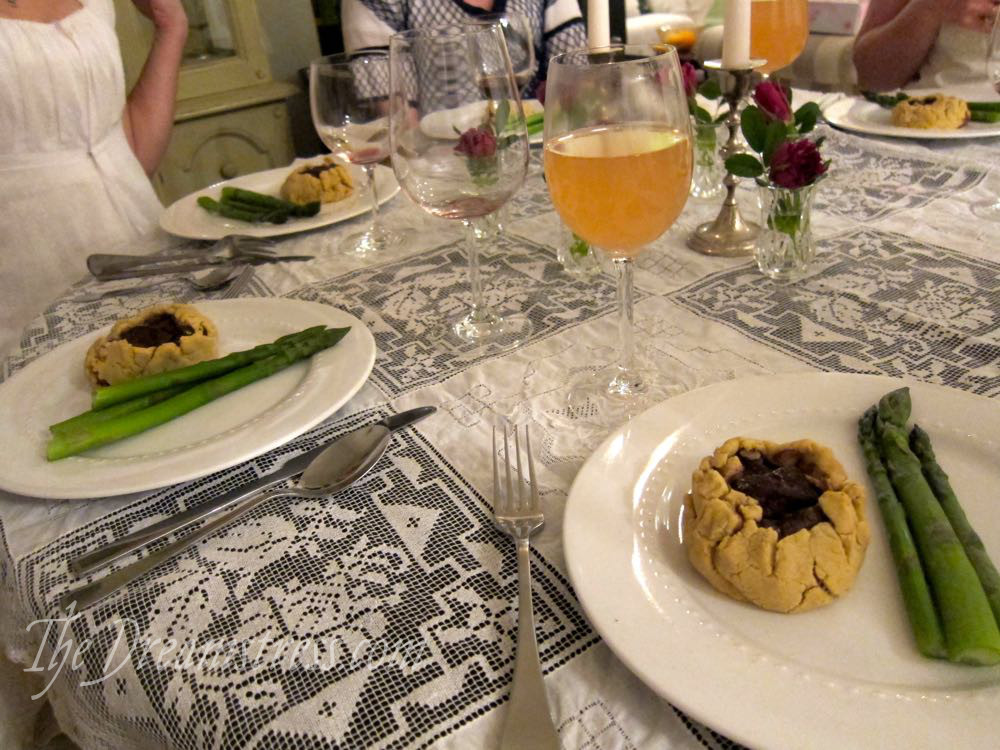
Dessert: Orange Jelly
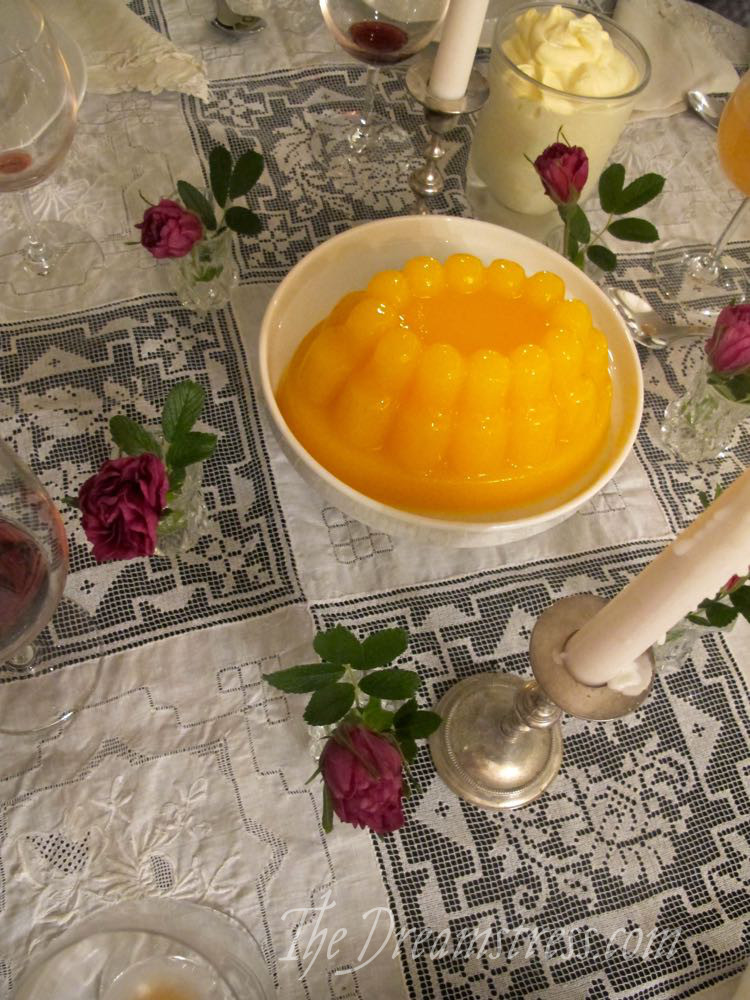
Nina made this spectacular jelly in the tiny kitchen, in an antique mould, using vegetarian gelatine.
She was understandably quite pleased with herself when it came out of the mould
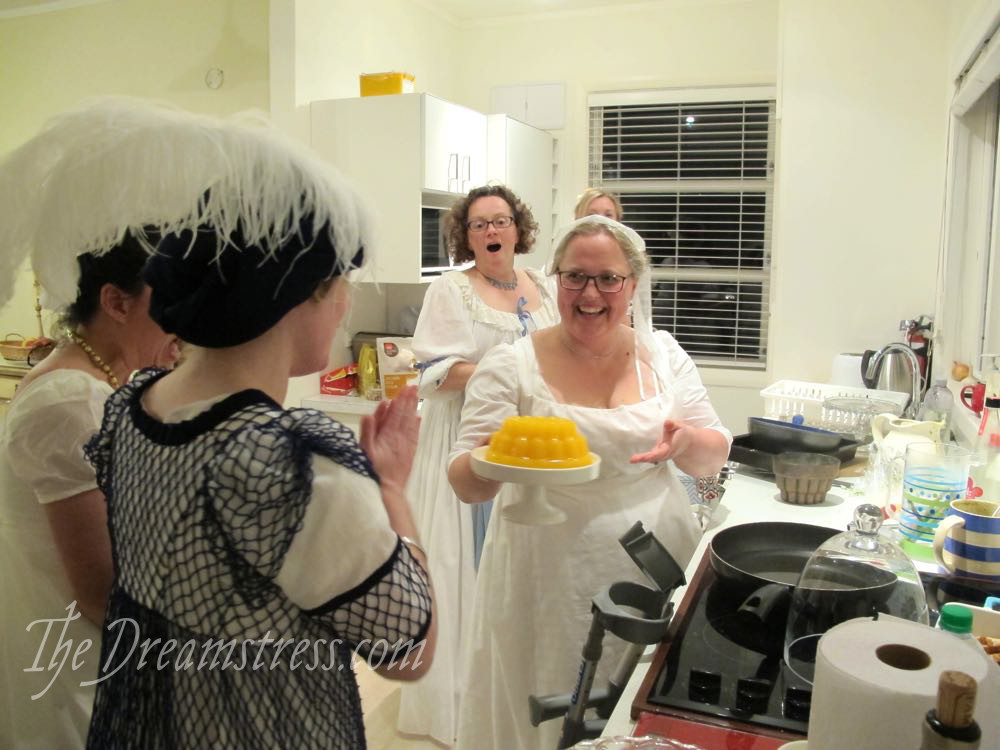
Nina had been so excited about making a jelly dessert the whole time we were menu planning that I didn’t have the heart to tell her that I absolutely loath jelly. §
So I thought I’d be in food purgatory for the last course, gagging down jelly and pretending to like it.
Happily, it turns out that true homemade jelly, made with vegetarian gelatine, two dozen oranges and no food colouring at all, is an entirely different beast § than the jello we got served at school.
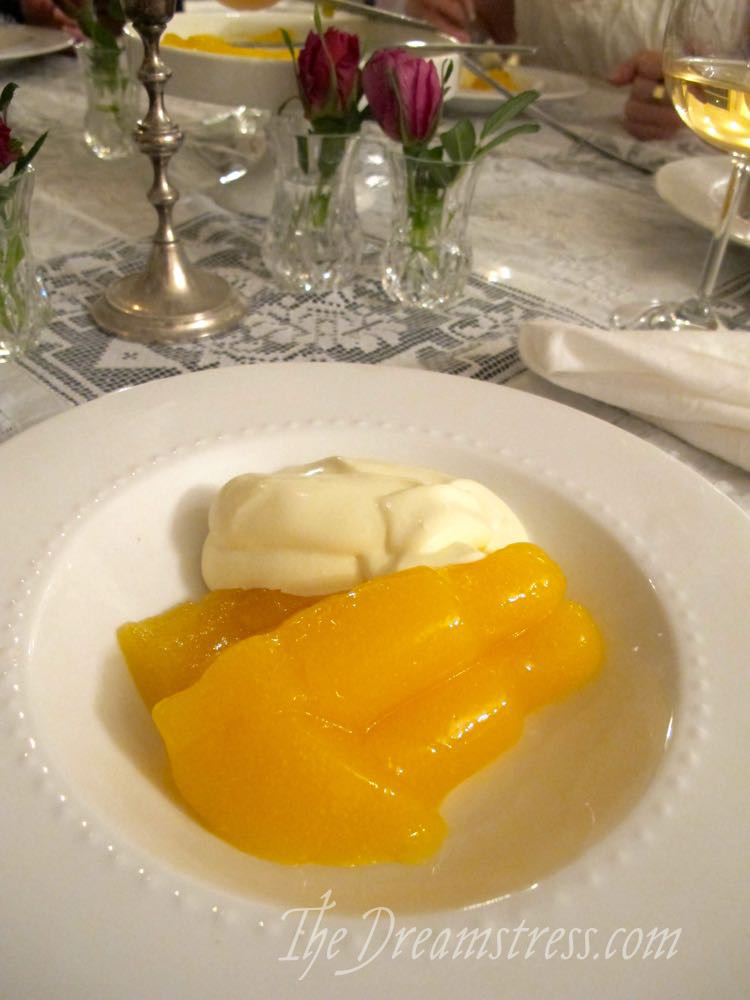
It’s delicious…
Breakfast
Just in case you were wondering, our morning food choices all three days weren’t quite so historic, but we didn’t let our standards slip:

Lace tablecloths, roses, marmalade in fancy bowls, pots of tea and fancily arranged fruit!
And, just because it’s funny, aprons and fancy dresses:
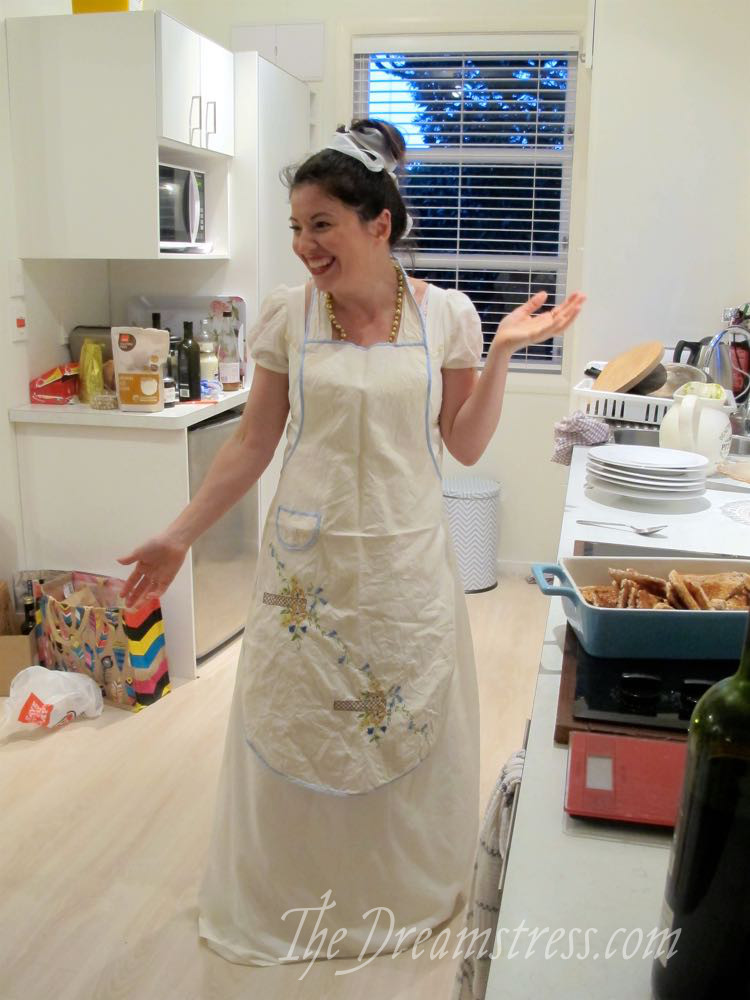
*And she did it all while on crutches!
** I will spare you images of the actual whole hare^.
^And the caption that says “things are getting hare-y”*.
* You have no idea the effort it took to resist that temptation…
*** Which I really just included as an excuse the dial the spices and spiceyness up by a factor of about 400%. I just can’t believe that a girl who comes from a culture that eats mustard and horseradish would be so overwhelmed by anything but a seriously robust curry – and I like my curries on the robust side.
†We used to joke there should be a ‘People of Moore Wilsons’ website, a la ‘People of Walmart’. It would feature ladies with 30 artichokes in their cart, and children wearing designer outfits that would cost more than my entire wardrobe.
††With even more spices! Because mmmmm….spices.
†††True story. I couldn’t remember the name of the bread, but I can remember what it means. So 30 seconds before writing this I was googling ‘devil fart bread’.
‡ These were both made by Nina from recipes from Mary-Anne Boermans’ Great British Bakes. I’ve gotten their names completely wrong, but I’m definitely not mistaken in how delicious they were….
‡‡ Which is clearly a much better name. Wouldn’t you rather eat at the Pot & Pineapple than Gunter’s?
‡‡‡ And also because frankly, that sounds a bit much…
§ When I try to eat it my mind becomes absolutely convinced that I’m eating slugs.^
^And you know how I feel about slugs.^^
^^Also, slugs in Hawai’i can carry rat lung disease, so eating one could literally kill you.
§ § Not a slug beast, for starters.

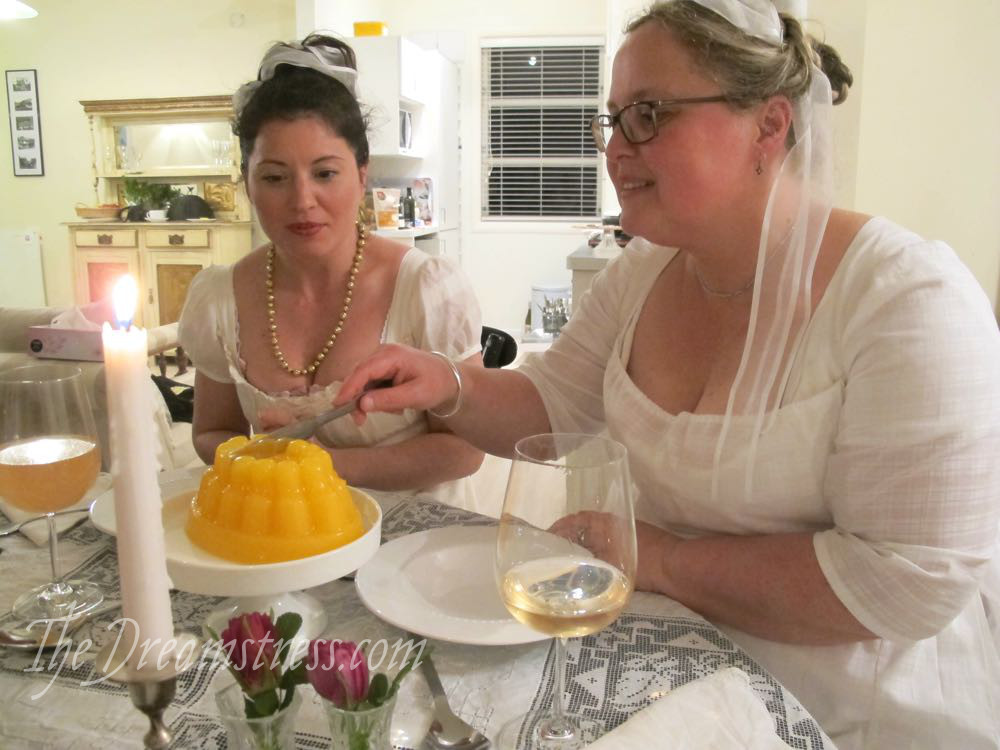
Yum! Yum! Yum! And why do people turn their noses up to British food? This all looks lovely, fresh, and delicious! (Ok, curry will be the much-loved step-child of “British” food) I have a food-list copied down from a 9th century census with very similar ingredients and equally mouth-watering effect.
But more than the ingredients, it looks like so much FUN went into the whole event that I cannot imagine a more tasty outcome! Hooray for everyone! Thanks for sharing your pictures of (delectable) food!
Oh–and thanks for the recipes, too.
Yum!!
I am the fortunate possessor of a copy of The Cookery of England by Elisabeth Ayrton, which is basically a historical cookbook of amazingness.
Though I don’t see eye to eye with her on the cooking of beef: “To cook beef more than this [no longer ‘underdone’ but still a bit pink] is a desecration and has no place in English cookery.” Having grown up in a country where undercooked meat can prove lethal, I like my beef well desecrated.
P.S. to the lady in red at Saturday afternoon tea: I hope you won’t take it amiss if I say that colour is stupendous on you.
historicfood.comIf you aren’t already a fan of his work, may I direct you to the website of Ivan Day?
I will watch any program on historical food, if it features Mr. Day and his superb cookery.
https://www.historicfood.com/Jellies.htm
That looks like so much fun!!! I truly wish i was more adventurous with my eating but I’m not so the orange jelly looks lovely to me!
Thanks for sharing and all the lovely photos!!!
Help. Going to the British High Commission ball this Thursday and need to invent a dress and make it by then. By combining the contents of my sewing projects box and a full white 1950s petticoat !
Such a lovely post. I found the recipes fascinating as I’m transcribing a diary of a local lady in the 1830s this also includes her account book 1832-38. This gives insight into how she ate and the clothing and accessories she bought. Some surprising items. How little most people know about how the well off ate in the C19, but at the other end of the scale how monotonous the diet of the poor was. Another Norfolk diary of Parson Woodford gives accounts of what he ate and how much meat they ate , he ended up with gout!